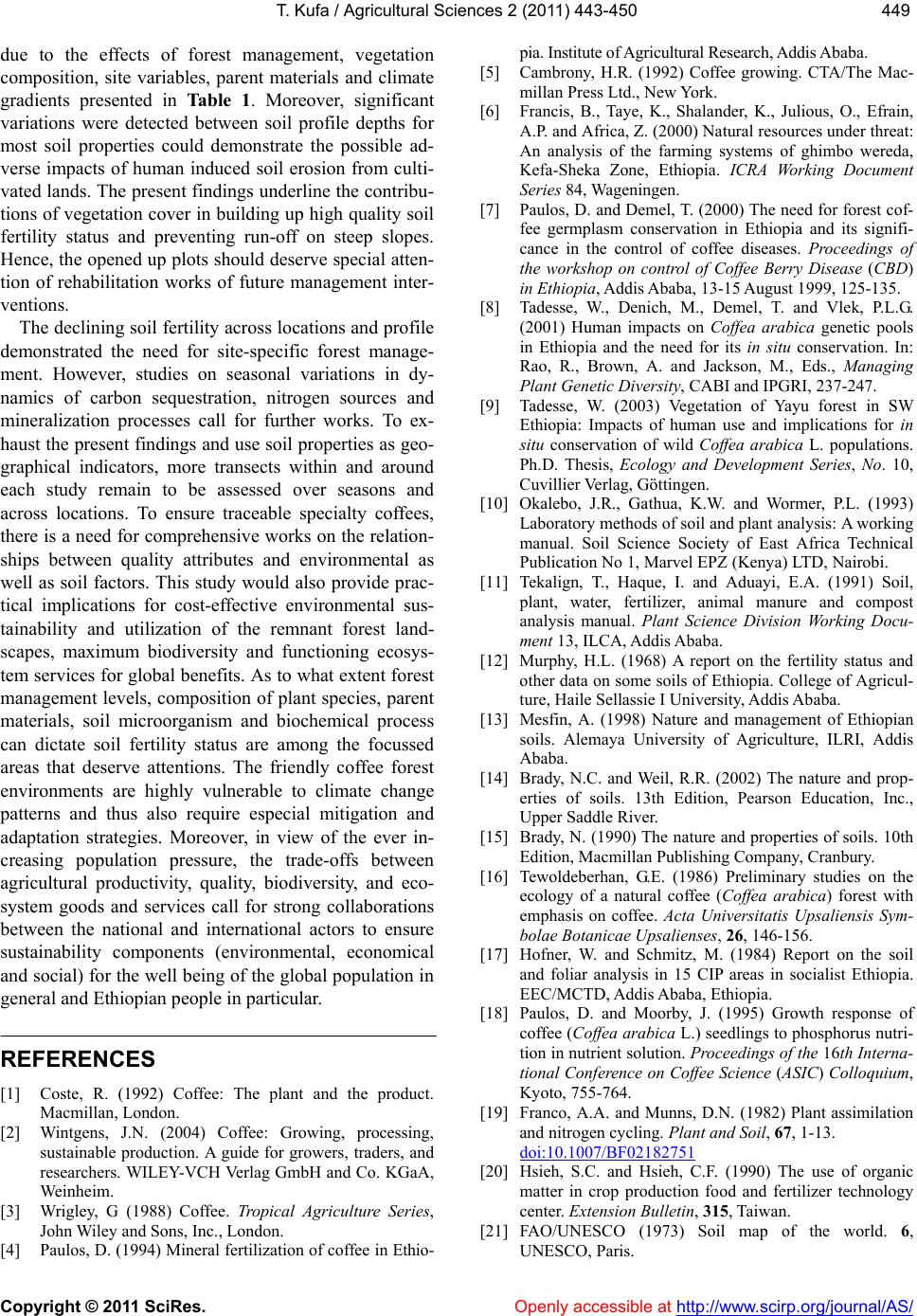
T. Kufa / Agricultural Sciences 2 (2011) 443-450
Copyright © 2011 SciRes. Openly accessible at http://www.scirp.org/journal/AS/
449449
due to the effects of forest management, vegetation
composition, site variables, parent materials and climate
gradients presented in Table 1. Moreover, significant
variations were detected between soil profile depths for
most soil properties could demonstrate the possible ad-
verse impacts of human induced soil erosion from culti-
vated lands. The present findings underline the contribu-
tions of vegetation cover in building up high quality soil
fertility status and preventing run-off on steep slopes.
Hence, the opened up plots should deserve special atten-
tion of rehabilitation works of future management inter-
ventions.
The declining soil fertility across locations and profile
demonstrated the need for site-specific forest manage-
ment. However, studies on seasonal variations in dy-
namics of carbon sequestration, nitrogen sources and
mineralization processes call for further works. To ex-
haust the present findings and use soil properties as geo-
graphical indicators, more transects within and around
each study remain to be assessed over seasons and
across locations. To ensure traceable specialty coffees,
there is a need for comprehensive works on the relation-
ships between quality attributes and environmental as
well as soil factors. This study would also provide prac-
tical implications for cost-effective environmental sus-
tainability and utilization of the remnant forest land-
scapes, maximum biodiversity and functioning ecosys-
tem services for global benefits. As to what extent forest
management levels, composition of plant species, parent
materials, soil microorganism and biochemical process
can dictate soil fertility status are among the focussed
areas that deserve attentions. The friendly coffee forest
environments are highly vulnerable to climate change
patterns and thus also require especial mitigation and
adaptation strategies. Moreover, in view of the ever in-
creasing population pressure, the trade-offs between
agricultural productivity, quality, biodiversity, and eco-
system goods and services call for strong collaborations
between the national and international actors to ensure
sustainability components (environmental, economical
and social) for the well being of the global population in
general and Ethiopian people in particular.
REFERENCES
[1] Coste, R. (1992) Coffee: The plant and the product.
Macmillan, London.
[2] Wintgens, J.N. (2004) Coffee: Growing, processing,
sustainable production. A guide for growers, traders, and
researchers. WILEY-VCH Verlag GmbH and Co. KGaA,
Weinheim.
[3] Wrigley, G (1988) Coffee. Tropical Agriculture Series,
John Wiley and Sons, Inc., London.
[4] Paulos, D. (1994) Mineral fertilization of coffee in Ethio-
pia. Institute of Agricultural Research, Addis Ababa.
[5] Cambrony, H.R. (1992) Coffee growing. CTA/The Mac-
millan Press Ltd., New York.
[6] Francis, B., Taye, K., Shalander, K., Julious, O., Efrain,
A.P. and Africa, Z. (2000) Natural resources under threat:
An analysis of the farming systems of ghimbo wereda,
Kefa-Sheka Zone, Ethiopia. ICRA Working Document
Series 84, Wageningen.
[7] Paulos, D. and Demel, T. (2000) The need for forest cof-
fee germplasm conservation in Ethiopia and its signifi-
cance in the control of coffee diseases. Proceedings of
the workshop on control of Coffee Berry Disease (CBD)
in Ethiopia, Addis Ababa, 13-15 August 1999, 125-135.
[8] Tadesse, W., Denich, M., Demel, T. and Vlek, P.L.G.
(2001) Human impacts on Coffea arabica genetic pools
in Ethiopia and the need for its in situ conservation. In:
Rao, R., Brown, A. and Jackson, M., Eds., Managing
Plant Genetic Diversity, CABI and IPGRI, 237-247.
[9] Tadesse, W. (2003) Vegetation of Yayu forest in SW
Ethiopia: Impacts of human use and implications for in
situ conservation of wild Coffea arabica L. populations.
Ph.D. Thesis, Ecology and Development Series, No. 10,
Cuvillier Verlag, Göttingen.
[10] Okalebo, J.R., Gathua, K.W. and Wormer, P.L. (1993)
Laboratory methods of soil and plant analysis: A working
manual. Soil Science Society of East Africa Technical
Publication No 1, Marvel EPZ (Kenya) LTD, Nairobi.
[11] Tekalign, T., Haque, I. and Aduayi, E.A. (1991) Soil,
plant, water, fertilizer, animal manure and compost
analysis manual. Plant Science Division Working Docu-
ment 13, ILCA, Addis Ababa.
[12] Murphy, H.L. (1968) A report on the fertility status and
other data on some soils of Ethiopia. College of Agricul-
ture, Haile Sellassie I University, Addis Ababa.
[13] Mesfin, A. (1998) Nature and management of Ethiopian
soils. Alemaya University of Agriculture, ILRI, Addis
Ababa.
[14] Brady, N.C. and Weil, R.R. (2002) The nature and prop-
erties of soils. 13th Edition, Pearson Education, Inc.,
Upper Saddle River.
[15] Brady, N. (1990) The nature and properties of soils. 10th
Edition, Macmillan Publishing Company, Cranbury.
[16] Tewoldeberhan, G.E. (1986) Preliminary studies on the
ecology of a natural coffee (Coffea arabica) forest with
emphasis on coffee. Acta Universitatis Upsaliensis Sym-
bolae Botanicae Upsalienses, 26, 146-156.
[17] Hofner, W. and Schmitz, M. (1984) Report on the soil
and foliar analysis in 15 CIP areas in socialist Ethiopia.
EEC/MCTD, Addis Ababa, Ethiopia.
[18] Paulos, D. and Moorby, J. (1995) Growth response of
coffee (Coffea arabica L.) seedlings to phosphorus nutri-
tion in nutrient solution. Proceedings of the 16th Interna-
tional Conference on Coffee Science (ASIC) Colloquium,
Kyoto, 755-764.
[19] Franco, A.A. and Munns, D.N. (1982) Plant assimilation
and nitrogen cycling. Plant and Soil, 67, 1-13.
doi:10.1007/BF02182751
[20] Hsieh, S.C. and Hsieh, C.F. (1990) The use of organic
matter in crop production food and fertilizer technology
center. Extension Bulletin, 315, Taiwan.
[21] FAO/UNESCO (1973) Soil map of the world. 6,
UNESCO, Paris.